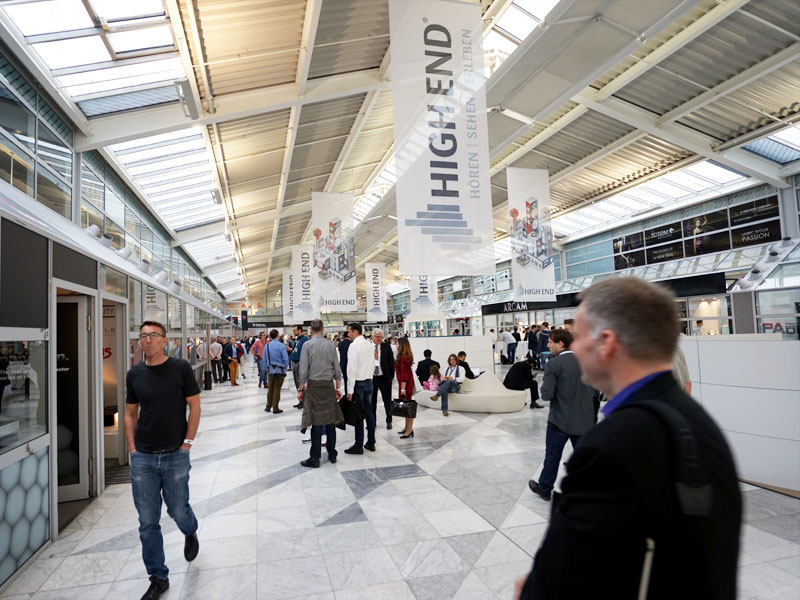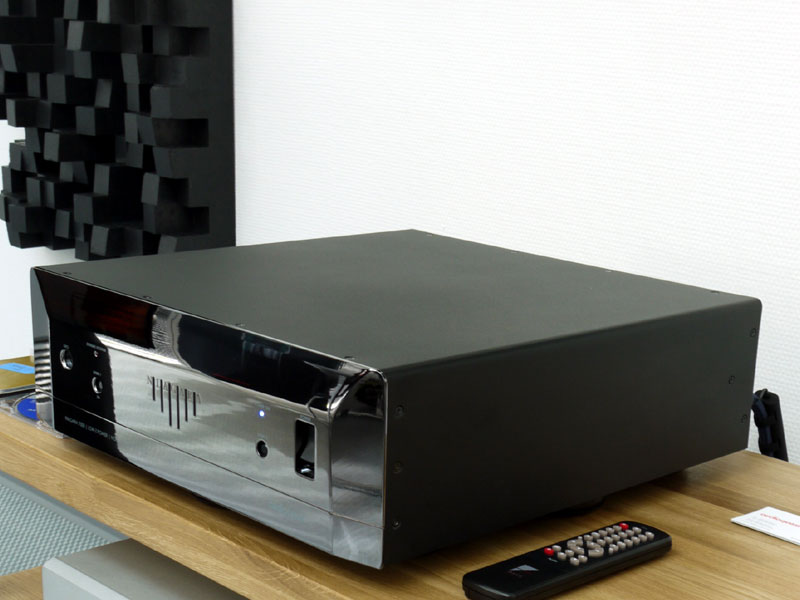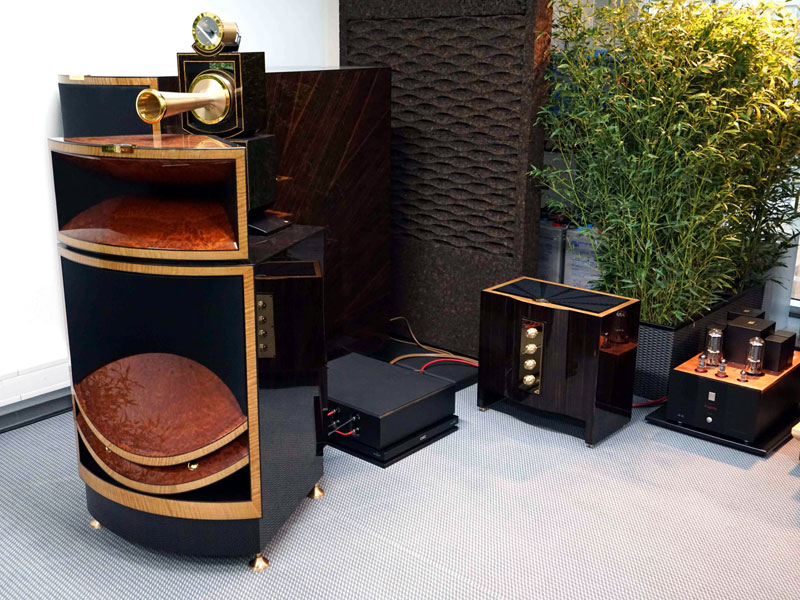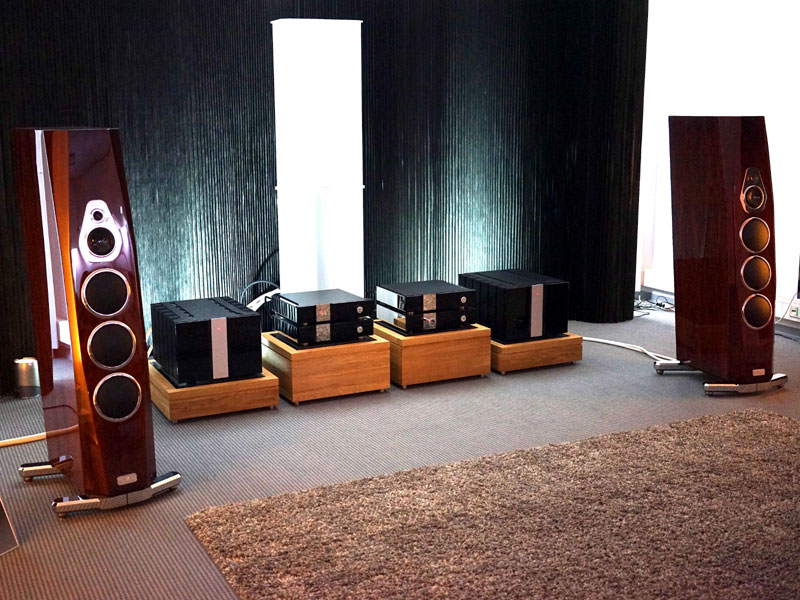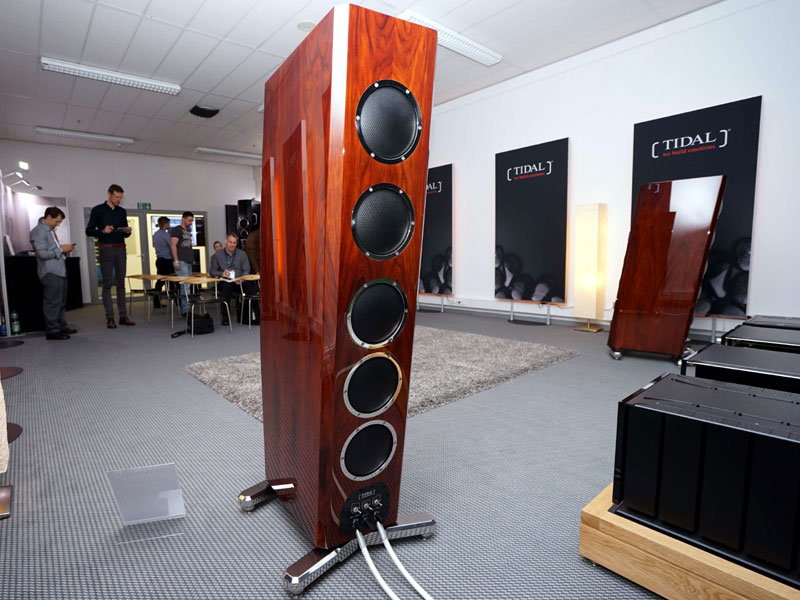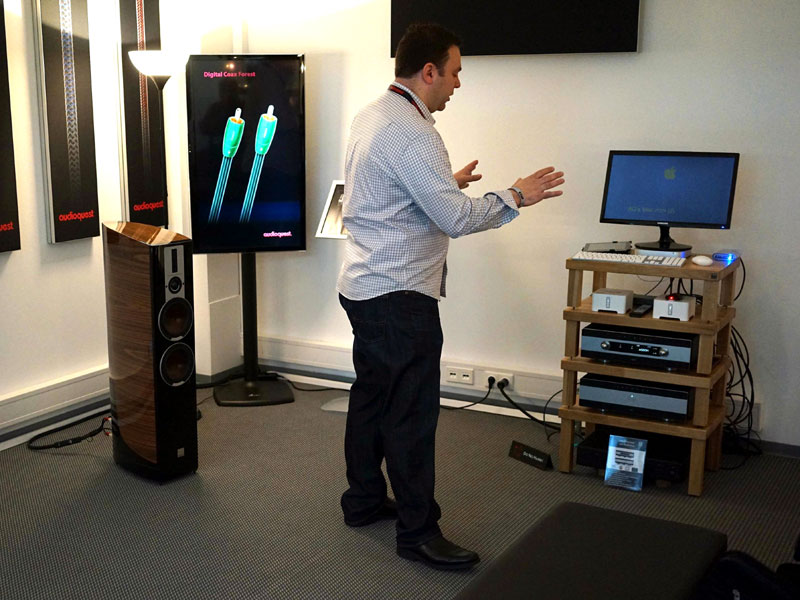High End 2015 • The Usual Suspects
hilst the Munich High End show has been the most significant global audio event for nearly a decade, a clue to its appeal lies in its title. Indisputably high end in nature, the hint I’m referring to lies in the word "show": This is the best place in the world to see hi-fi, but it’s not so clever when it comes to hearing it, and this year in particular that’s an understatement. Everything about the show seemed familiar: the normal beautifully presented rooms filled with visitors (nearly 21,000, trade and public, over the four days), the usual linguistic melange filling the long, narrow, straight corridors and open atrium spaces. But the sound? This year, musical standards (in every sense, but I’ll get to that later) reached an all-time low -- and it wasn’t hard to point a finger at the major culprit.
Ever since the late 1980s the audio industry has seized on one savior technology after another. First it was home theater and surround sound; then it was multiroom and home installation; now, to that unholy union you can add streaming and file replay. To quote the old saw, "Just because you could it doesn’t mean you should" -- except that in this case, with rooms devoid of a streaming source seemingly countable on the fingers of one hand, capability is far from a given. The amount of flat, recessed, compressed, turgid, muddled and downright tedious sound at the show points squarely to the fact that even if file-replay systems glory in the "plug ‘n’ play" moniker, the skill to make them work to hi-fi (let alone high-end audio) standards is sadly and almost universally lacking -- whether at the level of design or setup and application. If you think I’m overstating the case, consider this: In every single room where an alternative source was available, be it CD, SACD or LP, that alternative format didn’t just better the performance of the file-replay source, it beat it somewhere into the middle of next week, if not next month. Yet in every case, it was the server-based file-replay system that was playing when we walked into the room -- which rather raised the question, What were the exhibitors listening to, or were they actually listening at all? When I asked just that, the answer was always a variation on the "That’s what people want to hear" theme -- which is funny, because I always figured that what they wanted to hear was great sound and I’m darned certain sure that if this industry wants to survive it needs to sell performance, not convenience. Perhaps it’s no coincidence that one of the supposedly major events at the show was the series of Meridian MQA presentations. This is the latest compact, high-resolution-capable, backward-compatible file format, the format which will (if you believe what it says on the tin) make high-res downloads the preferred option across music consumers. It’s going to guarantee the musical and artistic integrity of all recordings; it’s going to deliver undreamt-of musical experiences; it’s going to establish a whole new benchmark for and expectations of audio performance; and it’s going to save the world as we know it, as well as our solar system and probably the rest of the universe too! Okay, so the presenter had all the grace of a stiff on the graveyard shift at QVC -- and pretty much the same audiophile credentials if the sonic results were anything to go by. Here’s a tip: If you are going to rave on about sound quality, make sure that what you are playing actually possesses or even deserves something approaching that description. Oh, and while you are about it, when you are selling the lossless nature of your format, that absolutely guarantees (for the first time in history, no less) that what the artist intended in the studio is what you’ll be hearing on your own system, isn’t it just a little incongruous to be playing analog masters from performers who are already sadly long gone. Or put even more simply, don’t say it sounds good when it clearly (and I do mean clearly) doesn’t.
All of which awkward clumsiness obscures a simple, unpalatable truth: ever since the arrival of the iPod, people have always had the option to listen to higher-resolution files formats (be that FLAC or WAV as opposed to MP3, or something involving bigger numbers), yet for the most part they simply haven’t bothered -- and MQA doesn’t provide the answer to that. What exactly is so compelling about yet another new acronym that promises yet another variation on pure, perfect sound forever? The problem with dumbing down the offer is that it also drops the bar -- real low -- and it’s seriously hard to recover from that. I’m sure that MQA, just like other streaming and file-replay solutions, is capable of way better, potentially even great performance, but that performance has to be deliverable and demonstrable. Lest you think this is an isolated example, how about the room offering up a sophisticated CD/SACD player with an option to configure it as a transport only, a proprietary link feeding DSD data directly to the matching two-box DAC, a flagship combination that tips the scales well the wrong side of €40,000? Part of Dennis Davis’s personal agenda for this show was hunting out a combination CD/SACD replay solution, preferably housed in a single box, so having discussed the player, the transport option and the data transfer system, he duly handed over an SACD to hear what it could do, the exhibitor duly obliging. Except that, before the end of the first track, he extracted the disc and invited us to experience how it sounded in the company’s new €12,000 media server, the product they were launching at the show. Fair enough, except that the musical performance duly dropped off the proverbial cliff. Even allowing for the difference in price, this was a catastrophic downgrade, rendering the recording almost unrecognizable as the same performance. We smiled politely, stuck it as long as we could and then asked if he could play it in the transport again -- which promptly restored sonic equilibrium. That is, until we noticed that the display on the player was indicating that it was upsampling the Red Book layer. The transport was already way superior to the server, but switching to the SACD layer raised its game significantly. Which, given that the system was set up to do just that and that the company had expended considerable effort on achieving that goal (very successfully I might add) raises the question whether they’d actually compared the various formats in the show system and what exactly they were trying to demonstrate? It’s almost as if the entire industry has decided that if a product doesn’t stream music nobody is going to be interested -- but they haven’t worked out that if it doesn’t do a decent job of the streaming it’s a waste of time anyway. If we actually admit the evidence of the Munich show, then both MQA and file replay in general is suffering a serious shortfall between promise and fulfillment, with much of the industry overdue a major reality check. If this really is the future, we’re in considerably deeper do-do than any of us realized.
Fortunately, there were islands of sanity amidst the mayhem, oases of musical refreshment amongst the rising tide of mediocrity. Not everybody has thrown the performance baby out with the streaming bath water, although the highlights were few and far between, in some cases very far indeed. Wilson Audio chose to debut the compact floorstanding Sabrina ($15,900/pair), previously only shown as an unpopulated cabinet, at a remote location some 45 minutes drive from the main event. Even so, it was worth the trip. Sabrina is built around a driver lineup based on the soft-dome tweeter and 8" paper-coned bass driver used in the Duette 2, the latter modified to match the larger internal volume and different bass loading, but combined with a new, 5 3/4" slotted pulp-coned midrange driver to create a true three-way design. The slim cabinet is significantly smaller than the Sophia 3's, its tapered profile and low waist further reducing its apparent size. Driven from a modest system comprising a EMM Labs XDS1 player and a Pass INT60 integrated amp, the sound was notably well integrated, lively and dynamic, with plenty of attack and no glare or hardness, even on tricky material at serious levels. Its compact dimensions and carefully voiced bottom end will certainly suit Europe’s smaller rooms, and the Sabrina seems set to become the free-space alternative/partner to the Duette 2 -- twin gateposts at the entry point to Wilson’s range.
One person you couldn’t possibly accuse of taking his subject less than seriously is Garth Powell, AudioQuest’s director of power products and designer of the company’s Niagara series of power-distribution units. I missed the presentation at last year's RMAF, as I was locked in a seminar room for most of the show, but Munich was my chance to both hear the product for the first time and hear the thinking behind it. On the face of things, the Niagara 7000 ($7995 and available toward the end of this year) looks like a fairly typical offering, but you soon realize that it’s anything but. A high-current, low-noise supply with 12 outlets, four for high-current devices (power amps) and eight for constant-current devices, split four and four across analog and digital, the 7000 should handle most systems, as long as the various elements are co-located (nobody has yet come up with an integrated solution that embraces remote monoblocks or projectors, but then that would probably mean playing with the fabric of space and time). Peak current capability is 80 amps, while source impedance is lower than you’d expect to get from your wall socket. When it comes to component quality, the attention to detail is remarkable, with in-house-designed, silver-plated beryllium copper socketry, pre-formed capacitors, and the wire used for winding the inductors and symmetrical, multiply screened and dielectrically biased, balanced isolation transformer (on the constant current outlets) being tested for directionality. With multiple patents pending, including one for the critical issue of ground-noise dissipation, this is an unmistakably serious response to what is a serious problem. But then, as Garth Powell is apt to point out, most of the other offerings out there are happy to do part of the job part of the time. The Niagara 7000 is a genuine attempt to deliver a one-stop solution for high-end systems, the whole AC enchilada as a carry-out. If the demonstrations conducted at the show are anything to go by, then it could just deliver on that promise -- at a price. Those in the know will respond, "What price clean power?" but that won’t help pad your bank account or provide a cash windfall, so it’s good that the Niagara series is planned to include the 5000 ($2995) and the single-device 1000 ($895). Mind you, the Niagara 7000 wasn’t the only product that AudioQuest were demonstrating at the show, but more on that later.
When it comes to great sound, High-End 2015 was very much a case of the usual suspects. For the best sound at the show you didn’t have to look much further than the Living Voice Vox Olympians, a staggeringly expensive system (from £625,000 for the full Olympian/Elysian setup) that seems to deliver staggeringly musical results with complete aplomb and without apparent effort. Of course, that ignores the massive effort that goes into installing a system like this and getting it to work so wonderfully well. Jason Kennedy has written about the setup separately, so I’ll limit my comments to pointing out that although this looks on the surface like the same CEC/Kondo-based replay chain seen for the last three years, including the Gakuoh push-pull 300B amps doing the driving, there are some differences tucked away beneath the surface. The Vox Elysian subs this year were a full-production pair (rather than the previous prototypes) that include a substantial reinforcing base plate and a retractable wheeled undercarriage, while their driving electronics were housed in matching and equally beautifully veneered cabinets. Just as significant is a change to the battery power supply (yes, the one that runs the whole system) with lead-acid cells in place of the previous lithium-ion battery packs. Bigger and considerably heavier, they also sound more natural, dynamic and offer a richer tonal balance, helping this million-dollar setup really sound like a million dollars, delivering even better sound this year than on its previous outings. To hear this system at its best you needed to be listening after 4:00 in the afternoon, but for all those who mutter darkly about vanity projects and expensive speakers that never sell, I’d suggest that a quick glance in the Living Voice order book might come as quite a shock. I’ll be visiting the cabinet factory later this year, and believe me, nobody builds products like this for stock, while the multiple sets already in production are about to be joined by the orders generated at this show. Yes, Living Voice: living proof that great sound actually does make sales.
Of course, this being Munich, the Vox Olympians were far from the only extravagant speaker system on show. After getting everybody all excited last year by announcing a diamond-midrange speaker, only to deflate that expectation by showing it sat in a display case, Tidal redeemed themselves this time around with not one but two speaker models using the driver. The system playing was the "more affordable" of the two, the €166,000/pair Akira, featuring just one of the exotic 5" drivers per channel, naturally paired with a 1.2" diamond tweeter. Bass drivers are the Accuton Cell-tech 9" units, with three units on the raked front panel and five passive radiators on the rear. The midrange driver itself is similar in design to a massive tweeter, driven by a circumferential voice coil with an annular-ring motor structure that is specifically designed to avoid rear reflection. It works down to 150Hz, with a very shallow crossover slope. The all-Tidal driving system (€50,000 worth of Assoluta mono amps, complete with silver-wound transformers, a €50,000 Presencio LS line stage and €50,000 Chimera DAC) was fed from an Aurender W20 network server and strung together with around €100,000 worth of Argento Flowmaster interconnects and speaker cables and Flow power cords.
That’s an expensive setup, even if it’s still comparatively modest by Vox Olympian standards. But musically speaking, the performance didn’t disappoint. Utterly seamless, it was fluid, unforced, expressive and finely nuanced. Intricate and delicate when necessary, it was also capable of remarkable power and sudden dynamic shifts when necessary. Subtle musical shadings and textures were explicit without being exaggerated, and the Akira made a powerful argument for its exotic driver technology. Once again, Tidal were one of the few companies that showed a traditional big-box, wide-bandwidth system and made it work. Once again it got better as the show went on, but past experience made sure I went back on Sunday and sure enough, the resulting musical coherence and astonishingly lucid performance were more than worth the wait. For those who find the Akira disturbingly affordable for a serious high-end speaker, there’s always the "If you have to ask" La Assoluta, with its twin-diamond-midrange driver array, a speaker that’s actually taller than its designer, Jörn Janczak -- and that’s saying something!
Another perennial sonic overachiever was the Brinkmann/Vandersteen system, where Vandersteen Model 7 Mk II loudspeakers ($62,000/pair) and matching M7-HPA amplifiers ($52,000/pair) were paired with Brinkmann electronics and turntable, all mounted in an HRS rack. Turntable was the Spyder ($14,000) running a Brinkmann 12.1 tonearm ($7500) and Brinkmann EMT cartridge ($4300) and the tube-driven RoNT power supply ($4300). The phono stage was Brinkmann’s Edison ($12,990) and line stage was the Marconi ($12,990), while the rack was an HRS SRX Signature and the cables were all AudioQuest WEL series, backed up by Shunyata Typhon and Triton power products. There was also a second, Brinkmann 10.1 tonearm carrying a Lyra Kleos, but we didn’t hear that. What we did hear was big, bold, dynamic and very, very musically engaging. Despite the system’s obvious dynamic capabilities it was also notable for the lack of artificial tonal intrusion, or any pushy, hurried quality. Instead, its relaxed, natural sense of rhythm and pace allowed music to breathe, while it also exhibited superb layering and dynamic discrimination. This system even made Diana Krall listenable and that is praise indeed! The delicacy and precise weighting of her piano notes was both intimate and convincing, bringing real authority to the musical performance. Vandersteens have figured prominently in many of our show reports over the years, with especially impressive results from a string of systems at RMAF, but I think this is the best sound I’ve heard from these speakers yet under show conditions. It made me wish I had the M7-HPA amps to go with the pair of review Model 7 Mk IIs I have at home right now. But perhaps the most interesting thing about these three stellar systems is that they each relied on a different source format, with Brinkmann and Vandersteen running from vinyl, Tidal streaming files and Living Voice playing exclusively CD -- each with excellent results. It demonstrates two, equally pertinent truths: You can get great results from any of these formats if you try hard enough and set about doing it in the right way, but just as importantly, the decision to discard any of these formats is dangerously premature. Just as all those who dumped their records when CD arrived, marry in haste, repent at leisure!
Which brings me to the last system I want to talk about. As good as it certainly was, it doesn’t qualify as the best sounding setup in absolute terms, but in many ways it was the most significant system on show. It was also my favorite system, partly because of what it did and partly because of how it was being used. It was to be found in one of the AudioQuest rooms and consisted of a Primare 60 Series preamp/power amp combination ($10,000 the pair) driving a set of Dali Epicon 6 speakers ($8000/pair). Source was a Mac Mini connected to a Sonos streamer. This beer-budget system, even in basic form, did many of the musically important things so much better than so many of the much more ambitious setups on show that you were forced to wonder who was kidding who -- and that was before the AudioQuest crew inserted their $149 Beetle DAC between the Sonos streamer and the Primare Pre 60. The dramatic (and I’m not exaggerating) increase in bottom-end weight, power, pitch, attack and sense of purpose had listeners wondering whether they could credit what they were hearing. Vocals gained focus, presence and a significantly more natural, communicative quality, rhythms tightened up, pace quickened and performances sprang to life. Impressive stuff, but they weren’t finished yet. Next up was the $49 JitterBug USB line conditioner. Inserting that in line with the output of the Mac Mini brought about another major step up in performance. Clarity, space and dimensionality all improved with a blacker background, lower noise floor and way better microdynamic definition, particularly apparent on vocals. This $200 AudioQuest upgrade created a system that was the very model of what a good mid-priced system should be: lively, articulate, engaging and above all, fun -- good, old-fashioned musical F-U-N. It definitely gets my vote for the most entertaining demonstration at the show while also delivering exactly the kind of musical integrity that so many -- indeed, the vast majority -- of the show systems lacked. It proved that you can get musically meaningful results from file replay -- and that it’s possible without spending a small fortune. Above all, it took the simple truth demonstrated by the Living Voice system and underlined it with a big, bold marker pen, highlighted the text and then shone a spot light on it: If sound sells, better sound sells a whole lot better. If Beetle and JitterBug are anything to go by, AudioQuest are only just getting started! The Duck For Cover Award 
As you should have gathered from the comments above, there was no shortage of candidates vying for this year’s coveted Duck for Cover award. From the Soulution/Magico system that managed to render even the Johanos/Dallas Rachmaninov Symphonic Dances sterile, dry and dynamically constipated, to the Tune Audio/Modwright/VPI setup, which used the enormous Anima speakers "augmented" by a pair of Kion prototype horn-loaded subs. I’ve heard detached bass and I’ve heard slow bass, but I’ve seldom heard bass that’s detached and divided into three separate but equally tuneless strands. There were systems where the wallowing low frequencies could almost bounce you from the room and others where the treble was so ear syringe-ingly astringent that it was painful to spend time there. There were those that were inappropriate (Astell & Kern trying to drive B&W 802D 2s in a prefabricated sound booth only a little bigger than a walk-in wardrobe) and those that were simply inexplicable (the truly gruesome sound produced by the Stenheim monster system). Despite all the worthy contenders, the award this year goes elsewhere. Hand in hand with the knee-jerk adoption of file replay as the show’s principle source comes the assumption of the superiority of "high-res" files and the associated imperative to play such material. Of course, even the most vociferous of computer-audio advocates has had to accept that the provenance of these files is extremely dubious, meaning that the range of reliable recordings is seriously limited. As a result, large portions of the audio industry have sleepwalked back into playing "audiophile dreck," a horrifyingly low-key musical zombie apocalypse. It’s a long, long time since I heard so much aimless guitar doodling, so many finger-cymbals and irrelevant wood-block percussion, so many wannabe jazz chanteuses. Serious note to exhibitors: it doesn’t matter how good your system sounds if the material you play is of no musical merit whatsoever. Please, somebody, can the nasty audiophile female vocals and play some Ella, Nina, Billie or Dusty. Hell, play some Gillian, Eliza, Ruth or Grace -- just stop with the beautifully recorded but musically bland pap and play something with a bit of attitude. So this year’s Munich High
End Duck For Cover is a collective award that goes to all those exhibitors who rifled the
audiophile back catalogue and then bored showgoers rigid with the results. You know who
you are. |


